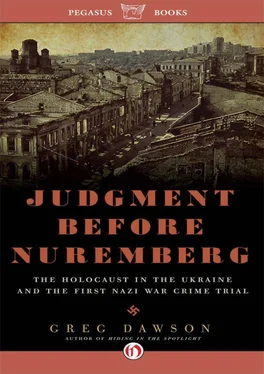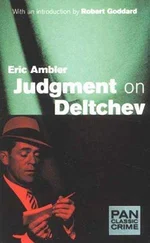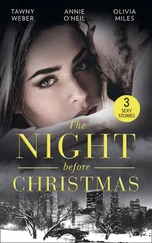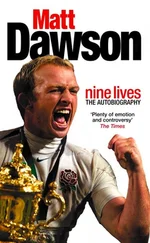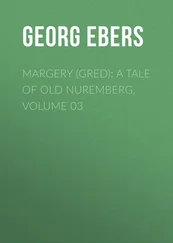In a Gallup poll taken in the immediate aftermath of the war when reports and images of the death camps were still fresh in the public mind, on average the respondents said only one million Jews had been murdered. The failure of American press coverage to leave readers with a coherent picture of the Holocaust was not one of quantity. The Times’ output was multiplied manyfold by newspapers big and small which ran stories by their own correspondents or picked up reports from wire services such as Associated Press, United Press, and Reuters. Nor was it a problem of quality. Read a random selection of stories and you find a high level of writing and reporting. Consider United Press correspondent Joseph Grigg’s report, filed in spring 1942, on the fate of Jews in western areas of the Soviet Union:
“Thousands lie in unmarked graves, many in mass graves they were forced to dig before the firing squads of SS troops cut them down. One of the biggest known mass slaughters occurred in Latvia in the summer of 1941 when, responsible Nazi sources admitted, 56,000 men, women and children were killed by SS troops and Latvian irregulars. This slaughter went on for days. One German rifleman boasted to correspondents that he had killed thirty-seven in one night, picking them off as a hunter does rabbits.”
Still, much of the coverage by America’s most influential newspapers remained muted by a persistent, almost pathological skepticism, some of it rooted in the memory of fabricated tales of German atrocities in World War I—raping of nuns, bayoneting of babies—which the press swallowed whole. The only problem was, now it was true. But even seeing was not believing for the Times’ Lawrence. In October 1943, with other American reporters, he visited Babi Yar, the ravine outside Kiev where the Nazis killed 34,000 Jews in two days. This was nearly a year after the Allies had issued a formal statement acknowledging the Nazi plan to exterminate all European Jews.
“On the basis of what we saw, it is impossible for this correspondent to judge the truth or falsity of the story told to us,” Lawrence wrote after the tour conducted by Soviet officials. “It is the contention of the authorities in Kiev that Germans not only burned the bodies and clothing, but also crumbled the bones, then shot and burned the bodies of all prisoners of war participating in the burning, except for a handful that escaped.”
Not everyone on the tour that day was so skeptical. United Press correspondent Henry Shapiro told of seeing remnants of human bones, hair, shoes, and dental bridgework in the dirt at Babi Yar. The New York Journal American put his story on the front page under the banner headline, “100,000 KIEV CIVILIANS KILLED BY NAZIS. Wholesale Massacre Revealed.” Predictably, the Times ran Lawrence’s story on page 3.
It’s hard to argue with the assessment of Max Frankel, former managing editor of the New York Times , who—in a November 2001 article in the Times under the headline “Turning Away From the Holocaust”—called his paper’s Holocaust coverage “surely the century’s bitterest journalistic failure.” Yet on a personal level, thinking of my Ukrainian grandfather and imagining walking a mile in Lawrence’s shoes at Babi Yar, it is possible to feel their existential pain and doubt—and to understand how both could have made such terrible misjudgments.
Indeed, Lawrence’s eyes-wide-shut reporting for what was regarded as the most sophisticated newspaper in the U.S. reflected the view of Americans from Main Street to Washington, D.C., where Supreme Court Justice Felix Frankfurter famously said he knew that the reports were true, he just didn’t “believe” them. And neither did my grandfather, Dmitri Arshansky. As a boy during World War I, Dmitri befriended the German soldiers who passively occupied his hometown, Poltava. In the fall of 1941 when rumors of Nazi atrocities in western Ukraine reached Kharkov, Dmitri refused to believe them, and resisted his brother’s pleading to join his family in fleeing east to the Urals before the Nazis arrived. “I know the Germans,” Dmitri told his brother, “they are not capable of such things.” People surely could not be capable of such things. Yet such things soon came to pass.
The virtual disappearance of the Kharkov trial from contemporary memory cannot be blamed on lack of coverage at the time. It received ample, ongoing front-page coverage in newspapers big and small across America, as well as Time and Life magazines. The Life spread had sixteen photos, including mug shots of the accused and stark images of the hangings in the marketplace. “In Kharkov on Dec. 13, 1943, a beginning was made toward Germany’s expiation of the immeasurable guilt that hangs over Europe today,” the story began. The caption under one photo of the executions noted that “The bodies hung for three days and nights.”
Days after the hangings, The Berkshire County Eagle in Pittsfield, Mass., was among many, many newspapers that devoted page-one space to a story by Glen Perry, a correspondent for the North American Newspaper Alliance.
“WASHINGTON—Nothing happening on the war front attracted as much attention in official circles here today as did the announcement that three Germans and a Russian traitor had been hanged in the public square of Kharkov after being tried and confessing their guilt in the mass killing of Russian civilians of the city before the Nazi army was driven out. The importance of the news, as Washington sees it, is out of all proportion to the mere fact that four men have been killed in a land which has seen millions of soldiers slain in battle. It is taken as notice to the world from Moscow that the Soviet Union was not fooling when it agreed that war criminals should face trial and punishment in the very towns their crimes took place. These four are the first of thousands who will pay the penalty for their misdeeds.”
Ironically—prophetically— Life’s Picture History of World War II , published in 1950, included no mention or photo of the Kharkov trial, or the extermination of Jews anywhere in Europe. The photos in Life’s 1944 feature were taken from a Russian film of the trial, We Accuse , shown in London and The Little Carnegie Playhouse in New York in June 1945, a month after the war ended.
The reviewer in Time said the film “documents the Kharkov war-criminal trials with the force of a pile driver. It shows hideous photographs and testimonials of the kinds of atrocities to which the accused plead guilty. Even more overwhelming are shots of bereaved women as they touch and caress the wounds and the frozen feet of their dead; or the restrained but colossal grief and passion for retribution in the faces of men and women in the audience as they react to the German secret field policeman’s admission that he is responsible for the deaths of ‘no more than forty’ Russian civilians.”
“As the first pictorial document of the swift bringing to justice of Nazi war criminals, We Accuse is a valuable casebook,” wrote the critic for the New York Times . “When the convicted four are led to the public square and hanged before surging mobs, the spectacle presented is more shocking than the surfeit of shots in the picture showing dead Russian women and children.”
We Accuse might have contributed more than it did to the American public’s awareness of events not yet known as the Holocaust. But distribution of the film was limited because it failed to gain the seal of approval of the Hays Office, which from 1930 to 1968 was charged with protecting public sensibilities and morality from what it deemed to be malign thoughts and images such as homosexuality, miscegenation, and certain dirty words. Thumbs down from Hays meant the film would not be shown in any theaters that honored the code.
Читать дальше
